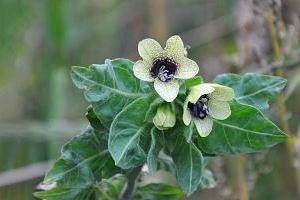Henbane
 I came across a flower of henbane the other day, a fascinating, rather peculiar plant that has plenty of attitude! Henbane is a member of the order of solanaceae, which also includes such plants as the potato, tomato, tobacco and nightshade family (including deadly nightshade). It has a large flower made up of creamy-yellow petals with purple veins that flow from a purple centre; this makes it look not unlike the whites of an eye, resulting in one of its country names of devil’s eye.
I came across a flower of henbane the other day, a fascinating, rather peculiar plant that has plenty of attitude! Henbane is a member of the order of solanaceae, which also includes such plants as the potato, tomato, tobacco and nightshade family (including deadly nightshade). It has a large flower made up of creamy-yellow petals with purple veins that flow from a purple centre; this makes it look not unlike the whites of an eye, resulting in one of its country names of devil’s eye.
Henbane is probably not native to Britain, but may have been bought over here for its medicinal properties, or possibly as a contaminant within seed imported from the continent. The plant contains tropine, which is a very toxic tropane alkaloid and if any reasonable quantity is ingested can result in death.
There are many reports however from people who have lived to tell the tale. One man in particular was Gustav Schenk, author of The Book of Poisons. While studying plants in remote parts of Europe, Schenk decided to roast a few henbane seeds and inhale the fumes. He quickly started to hallucinate that he was flying, which he found truly joyful though this feeling of elation was somewhat ruined by the sensation that his body was starting to dissolve. Perhaps most peculiar of all though, was his conviction that both his foot and arm had chatted away to him throughout the whole experience! Apparently, such is the strength of the plant that even to smell the flowers of henbane can cause giddiness.
Henbane may have had a number of different uses in the past, one of which was recounted by Dr Andrew Sharratt, who teaches Archaeology at Cambridge University. He was sat next to a lady at a dinner party who turned out to be a Danish Viking specialist (why do I never get to sit next to someone like that!). She had recently excavated a lady buried in the cemetery of the Viking fortress of Fyrkat; the body’s belt-pouch had contained over a hundred henbane seeds. She went on to remark that the plant was traditionally used in Jutland in chicken-stealing, to stun the intended victims. This may well be where the name ‘henbane’ originates.
Henbane was also used as one of the first anaesthetics, perhaps as long ago as the 12th century. A ‘soporific sponge’ was created by soaking the sponge in henbane, hemlock and perhaps opium. The well-soaked sponge was placed over the patient’s nose and mouth so that the fumes were deeply inhaled. Not only was the patient unconscious during the surgery, but often the anaesthesia took up to 96 hours to wear off, giving the patient some opportunity to recover from the trauma of the operation.
I imagine that one had to know what one was doing however, as it looks as though Shakespeare chose henbane to kill Hamlet’s father while in 1910, Dr. Crippen famously used the plant to source the chemical hyoscine, with which he murdered his wife.
So, it might just be my warped sense of humour, but I could not help but smile when I discovered that the celebrity chef Anthony Worrall Thompson, writing in Healthy & Organic Living Magazine, had recommended adding some of the plant as ‘a tasty addition to spice up a salad’! Imagine how easy it would be to spot the readers of this particular publication as they floated around our towns, chatting away to their slowly-dissolving arms!
Needless to say the magazine had to send out an urgent message which stated that under no circumstances should people try eating this ‘very toxic plant’. Apparently Thompson had meant to say fat-hen – which indeed makes a good, tasty and safe addition to a salad!
Peter Thompson
Advisory

Download Peter Thompson's essential 26-page book, featuring beautiful photography and detailed profiles of Britain's wildlife
Download FREE >